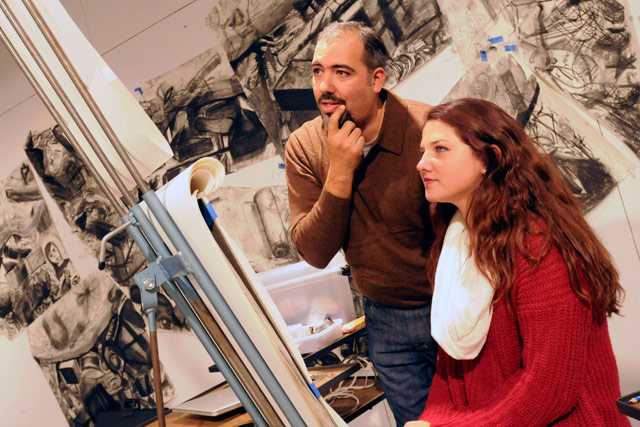 Committed to a BFA? The visual arts major is for you. Focus your talents on fine art or photography/video. All three take a cross-media, interdisciplinary approach that is rooted in the fine arts and guided by a faculty of nationally recognized artists and scholars. You graduate with a strong core. These essential skills and concepts are a foundation to draw on for life, as new artistic interests emerge and new professional opportunities arise.
Committed to a BFA? The visual arts major is for you. Focus your talents on fine art or photography/video. All three take a cross-media, interdisciplinary approach that is rooted in the fine arts and guided by a faculty of nationally recognized artists and scholars. You graduate with a strong core. These essential skills and concepts are a foundation to draw on for life, as new artistic interests emerge and new professional opportunities arise.
Foundation Courses
The BFA in Visual Arts is grounded in a strong foundation of core courses, which then allows students to narrow and intensify their focus as they acquire more diverse skills and mature as professional artists. After completing the Fine Art or Photography and Video specialization, students will be able to demonstrate knowledge and skills in the following areas: creative problem-solving, the use of technology and relevant traditional skills, an understanding of history and contemporary issues, visual and critical research, and writing and communication skills.
Drawing
The purpose of the course is to cultivate the student’s ability to express ideas visually and to develop confidence in drawing a variety of subjects with diverse materials. Exercises cultivate skill in determining composition, rendering geometric shapes, depicting perspective and three-dimensional illusions, fashioning light, shade, proportion, scale, surface, and texture, as well as arranging still-life compositions. Research and investigation of historical and contemporary drawing practices will be conducted.
Photography
This course is a guided studio experience in digital art with emphasis on 2D digital imaging. Investigations include the creative possibilities of graphics and the contemporary background of computers and digital arts. Students will use computer imaging and illustration to convey artistic concepts and personal observations pertaining to defined themes. Prior experience with the computer is not required. Extra lab hours outside of class meeting times will be required to complete assignments.
Visual Thinking
Visual Thinking initiates an investigation into current forms of artistic production. At the heart of Visual Thinking lies the question, “What is Art?” Visual Thinking challenges the traditional status of the art object as product and refocuses artistic creativity in the process of art making, the ideas invoked, and the meaning of cultural production. Among the approaches to art making that will be researched and put into practice will be the readymade, public intervention, performance, ephemeral works, language, and the use of signifiers.
2-D Design and Color Theory
This course provides essential concepts and skills necessary to function as a visual artist (graphic designer, digital artist or traditional fine artist). A strong emphasis is placed on the visual component of art, focusing on how to apply the elements of art (line, shape, color, texture, and space) to achieve one’s subjective goal. Color, as a visual element, is singled out in this course because of its complexity, importance in our visual environment, and the limited knowledge that entering students have regarding the subject.
3-D
This course focuses on projects that explore the fundamentals of form and space, investigating the proper materials, structure, mass, scale, light, and motion. Class discussions introduce a variety of conceptual and material processes that generate production. Intention, form, materiality, and context are the subject of general class discussion. Techniques and approaches may include the creation of objects informed by abstract ideas, performance involving 3D objects, and an introduction to 3D installations.
4-D
4-D introduces the concepts, theory, and fundamental practices of working with time-based media. Students will investigate the photographic frame, sequencing, and narrative construction. The relationship of image to time, image to text, and image to sound will be the basis of the examination. Students learn the basics of storyboarding and video imagery development. They are given project provocations to challenge their notions of photo and video structure and function. They are exposed to innovative work in the field and are required to read related writings.
Total for year: 6 Course Units
